Storage
|
 |
 |
 |
 |
Amphora |
Oval body with a vertical handle on either side. It
was used for storage of wine or sometimes oil. The name
"Amphora" is from the word "amphi"
means on both sides and "phero" means to bring.
Amphora is classified into "neck
amphora", which has a offset neck or "belly
amphora", which has a continuous profile from
the lip to the foot. Former has some sub-categories:
"nolan amphora"
with flaring mouth, "panathenaic
amphora" a prize for the winner of the game
at the Panathenaic festival, "nikosthenic amphora" derived from the Bucchero
pottery, "pointed amphora"
with a knob at the bottom.
Amphora was produced from the beginning of the black-figure
to the end of the red-figure and became slender in later
period. |
 |
Neck Amphora |
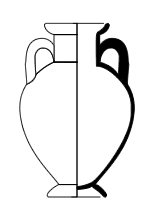
Oval body, a offset neck with a thick mouth, two vertical
handles and a heavy stand.
Some geometric amphora have a decoration "SOS"
on either side of the neck. Black-figured neck amphora
usually has a lotus-palmette pattern instead of "SOS"
and figured scene on the body.
Tyrrhenian amphora, made in the middle of sixth century,
has a tall body and the amphora made by Exekias or other
potter has a round body, and later amphora has intermediate
shape. Cf. Rhode 25.083 (Perseus
Project).
In the early year of the red-figure, neck amphora wasn't
so popular. "Nolan amphora",
a variety of neck amphora, was favoured in the first
half of the fifth century, and neck amphora with twisted
handles was preferred in the second half. Cf. Rhode 15.005 (Perseus Project).
Dimensions: height about 40cm, late black-figure example
is about 25cm and some late red-figure is over 60cm
|
 |
Nolan Amphora |
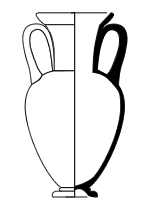
Oval body, a offset flaring neck, handles and a heavy
stand. The name was derived from the site where many
nolan amphorae were found.
Workshops of the early fifth century, probably of the
Berlin painter, introduced this shape and his follower
preferred this shape, although it was disappeared in
the second half of the century.
Figured scene is arranged on the body and the ornament
is usually a meander pattern intended for the ground
line. Cf. Rhode 23.323 (Perseus
Project).
Dimensions: height about 30cm
|
 |
Panathenaic Amphora |

Broad body tapering sharply downward, a offset neck
with a heavy mouth, handles cylindrical in section and
a small stand.
It was used as a prize for the Panathenaic game held
every four years and olive oil harvested from the trees
in Academia was contained.
Figured scene is arranged on either side of the body,
Athena between the columns is on one side, Tampa 86.24 (Perseus
Project), the game he won on the other.
The oldest example is about 560 B.C. and painted by
the black-figure in the age of the red-figure and hellenistic
period. Since the fourth century, the name of Archon
for the year was appeared by the right hand column.
There are many other subject for this shape, though
these were not for the prize, and flourished in the
first half of the fifth century. Cf. Philadelphia 31-36-11 (Perseus
Project).
Dimensions: height about 60cm, late example is about
80cm
|
 |
Pointed Amphora |
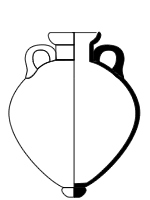
Round body, a offset neck with a heavy mouth, handles
cylindrical in section and a small knob instead of a
stand. It was probably placed on a stand.
It was painted by the black- and red-figure, although
produced only the first half of the fifth century.
Figured scene is arranged on the body. Cf. Toledo 1958.69A (Perseus
Project).
Dimensions: height about 50-60cm
|
 |
Nikosthenic Amphora |
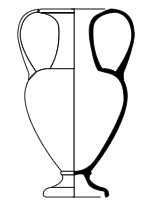
Oval body with offset neck, a broad handle on either
side and flaring stand. This shape was introduced from
the Bucchero pottery by the potter Nikosthenes in about
530 B.C. It was painted by the black- and red-figure,
though disappeared in the early fifth century.
The figured scene is arranged on the body, the neck
and the handles. Cf. Rhode 23.303 (Perseus
Project).
Dimensions: height about 30cm |
 |
belly Amphora |
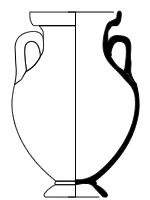
Oval body with a continuous profile from the lip to
the foot and two handles. It is classified into three
from the shape of the handle and the lip: type A has
a flaring lip and flat handles with flanges, Cf. Philadelphia MS3442 (Perseus
Project), type B has a flaring lip and handles cylindrical
in section and type C has rolled lip and cylindrical
handles. Cf. Harvard 1972.42 (Perseus
Project).
Type B is the oldest, appeared in the first half of
the sixth century, and type C is preferred by the red-figure
painters.
Figured scene is arranged on the body and a ray-pattern
is applied on the lower part of the body. A ivy pattern
is arranged on the handle of type A. A lotus-palmette
pattern is preferred by the black-figure painter for
the frame of the picture. Some red-figure painters used
only a meander patterns for the ground line.
Dimensions: height about 60cm(type A), 20-50cm(type
B), 40cm(type C)
|
 |
Pelike |

Round body with the widest portion toward the base and
a broad neck forming a continuous curve with the body.
This shape was probably developed from belly
amphora type C and used as a container for wine
or oil. The name "Pelike" was used for the
various shape, kylix,
oinochoe or lekanis
and modern scholar applied it for this shape.
Pelike was introduced at the end of the sixth century
and made till the end of the vase-painting. Figured
scene is arranged on the body. The way of decoration
is similar to belly amphora, though usually roughly
painted. Cf. Harvard 1925.30.46 (Perseus
Project).
Dimensions: height about 20-50cm, usually 30-40cm |
 |
Stamnos |
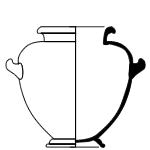
Round body, a offset short neck with a wide mouth, loop
handles placed high on the body and curving slightly
upward and a heavy stand. The name "Stamnos"
seems to be used not only for the shape, but also amphora
or pelike.
It was introduced in the late sixth century and preferred
by the red-figure workshops.
Figured scene is arranged on the body. A ornate palmette
pattern is arranged on either side under the handles.
Cf. Harvard 1925.30.40 (Perseus
Project).
Dimensions: height about 30-40cm, rarely over 60cm
|
 |
Transport Amphora |
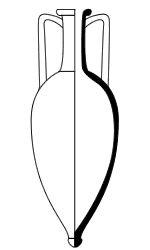
A large amphora used for mainly transporting wine.
The shape is generally tall and has a pointed foot.
It is explained that the shape was convinient to pile
up the vases, rather than the shape with a heavy and
large foot. The vase was stored on a stand or buried
into the ground. The shape is varied from region to
region, which is helpful to identify the manufactured
place. Later examples have stamps on the handles with
the year of harvest. Cf. Rhodian
Amphora from Paphos (University
of Sydney).
Dimensions: height about 50-70cm
|
 |
Pithos |
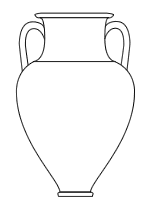
A large storage vessel, often buried into the ground.
It sometimes has relief decoration. Cf. Sparta
(Laconian
Professionals ).
Dimensions: height about 1m, but some exaples are
over 2m
|
|
 |
|
|
|